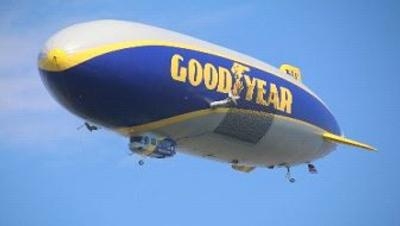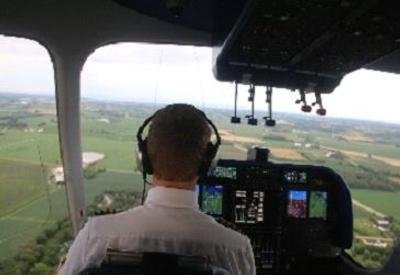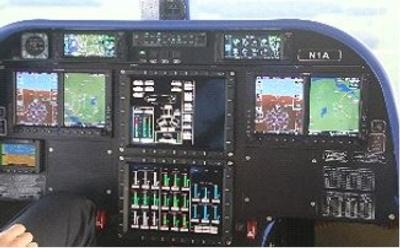Wingfoot One, Goodyear's Newest Airship
By Bruce Brandon
Wingfoot One, the newest of the iconic Goodyear blimps (technically it is a dirigible because it has semi-rigid internal frame and a blimp is non rigid, but Goodyear, in keeping with tradition of it previous airships, calls it a blimp.) was gracing the beautiful blue skies of AirVenture providing magnificent views both to those on the ground and its passengers.

Ed Ogden, PR for Goodyear, was kind enough to allow Aero-News to fly on this wonderful machine during AirVenture. Having flown aircraft from the J-3 to the C-130 to the A-330 for 49 years with 20,000 plus hours I didn’t think I could be wowed. I was wrong.
The crew was exceptional. Jorge Reyes, a former member of the U.S. Army 82nd Airborne is one of the crew chiefs and he graciously explained the operation. It takes a crew of 20 people to accompany Wingfoot One, including three mechanics. The crews spend approximately 80-100 days on the road covering all types of events, from football to the Kentucky Derby. Goodyear maintains a fleet of three blimps at, Pompano Beach, FL, Suffield, OH (near Akron), and Carson, CA.
Wingfoot One is the newest addition to Goodyear’s fleet. Two more are on the way. It was designed by Zeppelin in Germany and assembled in Ohio by Zeppelin and Goodyear engineers. It is a modification of the Zeppelin NT (new technology) and is state of the art. The cockpit is similar to any new jet airliner, all glass instruments and fly by wire.
Captains Jerry Hissem and Mike Dougherty were in charge and were extremely generous and patient as they were peppered with questions from the passengers. And questions there were. Flying an airship is unique. There is nothing comparable to it. The difficulty factor was described as that of flying a helicopter (as opposed to more difficult than flying a helicopter for the older blimps). Wingfoot One has no rudders (the older blimps do) and three 200 hp Lycoming engines with reversible propellers. The side engines can be rotated from 0 degrees (aligned with the longitudinal axis of the airship) upward 120. The tail has two propellers perpendicular with each other, one of which can be rotated to 90 degrees down. The thrust vectors of the propellers is in integrated into the fly-by-wire computers so as to optimize performance. This is particularly helpful when docking (similar to side thrusters on an ocean liner). The thrust vectoring allows vertical takeoffs and landings.

As in most large airplanes, the CG must be managed in flight. This challenge is exacerbated in a blimp because not only the burning of fuel changes the CG, the unequal heating and cooling of the helium by the sun (and clouds blocking it) affects it. CG is maintained in Wingfoot One by the captain moving the helium in the envelope between the fore and aft helium bladders with cockpit controls. Additionally there are three air valves and one fan to keep the envelope properly inflated.
Becoming a blimp pilot requires up to a year of training. As stated above, the skills are unique. While Captain Dougherty made it look easy (like Roy Mcllory makes golf look easy), close observation revealed that he was using many complex and unique aeronautical skills at once. Skills that took time and great aptitude to acquire.
Being a blimp passenger is a delight. Gliding over the beautiful Wisconsin landscape in the quiet gondola with its windows open is simultaneously relaxing and exhilarating. One can easily imagine traveling the oceans in the early Zeppelins (1928-1937) in the splendor of the European aristocracy before World War II.
Rides on Goodyear’s blimps are by invitation only. If the opportunity presents itself, take the ride of a lifetime on Wingfoot One!
(Images provided by the Author)

 NTSB Final Report: Patriot Aircraft LLC CX1900A
NTSB Final Report: Patriot Aircraft LLC CX1900A Aero-News: Quote of the Day (12.06.25)
Aero-News: Quote of the Day (12.06.25) ANN's Daily Aero-Term (12.06.25): High Speed Taxiway
ANN's Daily Aero-Term (12.06.25): High Speed Taxiway ANN's Daily Aero-Linx (12.06.25)
ANN's Daily Aero-Linx (12.06.25) Airborne-NextGen 12.02.25: Honda eVTOL, Arctus High-Alt UAS, Samson Patent
Airborne-NextGen 12.02.25: Honda eVTOL, Arctus High-Alt UAS, Samson Patent





